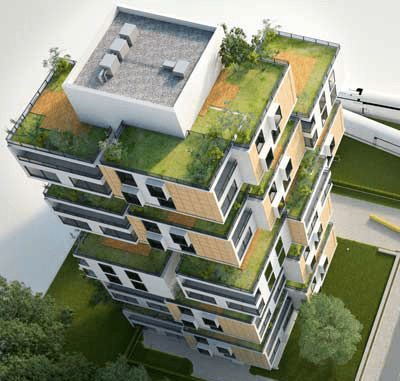Sneha Asrani
Centre for Advanced Research in Building Science and Energy (CARBSE), CEPT University, Ahmedabad, India
Corresponding Author: sneha.asrani@cept.ac.in
Rajan Rawal
Centre for Advanced Research in Building Science and Energy (CARBSE), CEPT University, Ahmedabad, India
Yash Shukla
Centre for Advanced Research in Building Science and Energy (CARBSE), CEPT University, Ahmedabad, India
Ravi Chaudhary
IIFL Home Finance Limited, Gurgaon, India
Ajay Jaiswal
IIFL Home Finance Limited, Gurgaon, India
Monu Ratra
IIFL Home Finance Limited, Gurgaon, India
Cite this article
Highlights
- Green Affordable Housing (GAH) project’s sustainability is expressed using four Key Parameters: Climate Response, Climate Resilience, Gender Sensitivity, and Affordability.
- Relationships between prevailing Green Building Rating Programs’ (GBRP) criteria and Key Parameters explored.
- Insights into the on-ground execution of GBRP criteria gathered from Green Building Rating Agencies and Consultants.
- Gaps in the prevailing GBRPs were identified.
- Suggestions are made to prevailing GBRPs to enhance their future relevance.
Abstract
Resource-efficient buildings conducive to occupants’ health and well-being are termed Green Buildings (GB). Dedicated organizations, called Green Building Rating Agencies (GBRA), are involved in formulating Green Building Rating Programs (GBRP). The GBRPs feature predetermined, intent-based Rating Criteria (RC). Their rating mechanism is based on a relative comparison between the building’s base-case and Green-iteration, apathetic to its absolute operational performance.
This study identified four Key Parameters: Affordability, Gender Sensitivity, Climate Response, and Climate Resilience, representing a Green Affordable Housing (GAH) project’s holistic – Financial, Social, and Environmental – sustainability. GBRPs were studied to gauge whether and to what extent the RC embodies the Key Parameters. Concurrently, inputs regarding the on-ground execution of GBRPs were gathered from GBRA and Consultants. This study illuminates the gaps in the prevailing GBRPs and makes suggestions to maintain their future relevance. It concludes with the requirement of a rating framework anchored to absolute design baselines and operational performance benchmarks.
Keywords
Green Building Rating Programs; Green Affordable Housing; Climate Resilience; Adaptation; Holistic Sustainability
References
- J. B. R. Mathews, Ed., “Global Warming of 1.5°C. An IPCC Special Report on the impacts of global warming of 1.5°C above preindustrial levels and related global greenhouse gas emission pathways, in the context of strengthening the global response to the threat of climate change,” IPCC, 2018., 2018.
- Floodlist, “Flooding and floods in Europe,” 2022. https://floodlist.com/europe
- D. Simeral and C. Riganti, “U.S. Drought Monitor,” 2022. https://droughtmonitor.unl.edu/
- WMO, “Heavy rains and flooding hit large parts of Asia,” 2022. https://public.wmo.int/en/media/news/heavy-rains-and-floodinghit-large-parts-of-asia
- S. E. Perkins-Kirkpatrick and S. C. Lewis, “Increasing trends in regional heatwaves,” Nat. Commun., vol. 11, no. 1, p. 3357, 2020. https://doi.org/10.1038/s41467-020-16970-7
- WMO, “Atlas of Mortality and Economic Losses from Weather, Climate and Water-related Hazards.” https://public.wmo.int/en/resources/atlas-of-mortality
- McKinsey & Company, “The next normal in construction,” 2020. Accessed: Aug. 01, 2023. [Online]. Available: https://www.mckinsey.com/~/media/McKinsey/Industries/Capital Projects and Infrastructure/Our Insights/The next normal in construction/The-next-normal-in-construction.pdf
- United Nations Environment Programme, “2022 Global Status Report for Buildings and Construction: Towards a Zero‑emission, Efficient and Resilient Buildings and Construction Sector,” Nairobi, 2022. [Online]. Available: globalabc.org
- U. S. Green Building Council, “What is a Green Building?” https://www.usgbc.org/articles/what-green-building
- N. Joshi, “Green Building Costs Just 10-12% Higher Than Conventional Ones,” RoofandFloor, 2021. https://roofandfloor.thehindu.com/raf/real-estate-blog/green-building-costs-just-10-12-higher-than-conventional-ones/
- The World Bank, “Urban Population (% of total population).” https://data.worldbank.org/indicator/SP.URB.TOTL.IN.ZS
- S. Kawamura and C. Brady, “Sustainable and Affordable Housing,” 2023. Accessed: Aug. 01, 2023. [Online]. Available: https://worldgbc.org/wp-content/uploads/2023/05/C22.9056-WGBC_Affordable-Housing-Report_Master-2.pdf
- MoHUA, “Light House Projects.” https://ghtc-india.gov.in/Content/LHP.html
- BMTPC, “Demonstration Housing Project using Emerging Technologies.” [Online]. Available: https://pmayurban.gov.in/uploads/presentations/1BMTPC-Demo-Housing.pdf
- Indo-Swiss Building Energy Efficiency Project, “Case Study on ‘Green’ Affordable Housing: Smart GHAR III, Rajkot,” 2018. [Online]. Available: https://www.gkspl.in/wp-content/uploads/2018/10/BEE1i.pdf
- UN, “Affordable housing key for development and social equality, UN says on World Habitat Day,” 2017. https://www.ecomena.org/world-habitat-day-2017/
- MoHUA, “Housing for All Mission: Scheme Guidelines,” 2021. [Online]. Available: https://pmay-urban.gov.in/uploads/guidelines/60180813309f2-Updated
- UNICEF, “Gender Equality – Glossary Of Terms And Concepts.” 2017, [Online]. Available: https://www.unicef.org/rosa/media/1761/file/Genderglossaryoftermsandconcepts.pdf
- IGBC, “IGBC Green Affordable Housing,” no. May. 2017, [Online]. Available: https://igbc.in/igbc/html_pdfs/abridged/IGBCGreenAffordableHousing.pdf
- GRIHA, “GRIHA for Affordable Housing: Abridged Manuel.” 2017, [Online]. Available: https://www.grihaindia.org/sites/default/files/pdf/Manuals/griha-abridged-manual.pdf
- GEM, “GEM Sustainability Certification Rating Program.” 2020, [Online]. Available: https://greenassocham.com/property/ckfinder_img/files/REFERENCEGUIDE.pdf
- EDGE, “EDGE: Certify Green and Change Your World.” https://edgebuildings.com/
- BEE and AEEE, “State Energy Efficiency Index 2020,” 2021.
- Reserve Bank of India, “Publications.” https://m.rbi.org.in/scripts/PublicationsView.aspx?id=20680
- BIS, National Building Code of India 2016. New Delhi: Bureau of Indian Standards, 2016.
- G. Azhar, S. Saha, P. Ganguly, D. Mavalankar, and J. Madrigano, “Heat Wave Vulnerability Mapping for India,” Int. J. Environ. Res. Public Health, vol. 14, no. 4, p. 357, Mar. 2017. https://doi.org/10.3390/ijerph14040357
- BMTPC, Vulnerability Atlas of India, 3rd ed. 2019.
- BEE, Eco-Niwas Samhita 2018, vol. 1. 2018.
- NDMA, Beating the heat: How India Successfully Reduced Mortality Due to Heat Waves. Ministry of Home Affairs, Government of India.

 Bishal Thapa
Bishal Thapa





 Fred Sherman
Fred Sherman Sumedha Malaviya
Sumedha Malaviya Satish Kumar
Satish Kumar












 The three main global energy concerns of providing access to modern energy, enhancing the security of the energy supply, and minimising the impact of energy systems on the climate have an impact on both national and international energy governance. To develop solutions that address the many facets of these difficulties, however, a variety of actors and stakeholders must be included due to the complexity of the energy challenges.
The three main global energy concerns of providing access to modern energy, enhancing the security of the energy supply, and minimising the impact of energy systems on the climate have an impact on both national and international energy governance. To develop solutions that address the many facets of these difficulties, however, a variety of actors and stakeholders must be included due to the complexity of the energy challenges. Cities are responsible for more than 70% of the world’s energy consumption and 40% to 50% of its greenhouse gas emissions. Managing increasing urbanisation is a challenge, and nations must deal with the effects it will have on the environment in terms of energy and climate.
Cities are responsible for more than 70% of the world’s energy consumption and 40% to 50% of its greenhouse gas emissions. Managing increasing urbanisation is a challenge, and nations must deal with the effects it will have on the environment in terms of energy and climate. Our transition to a future with lower carbon emissions depends heavily on buildings. They are our places of residence, rest, and employment; they also account for around one-third of the world’s greenhouse gas emissions and nearly 40% of the world’s energy usage.
Our transition to a future with lower carbon emissions depends heavily on buildings. They are our places of residence, rest, and employment; they also account for around one-third of the world’s greenhouse gas emissions and nearly 40% of the world’s energy usage.